Zin Lin
In-situ Physical Adjoint Computing in multiple-scattering electromagnetic environments for wave control
Mar 27, 2025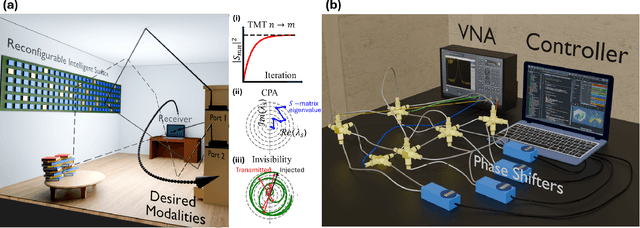

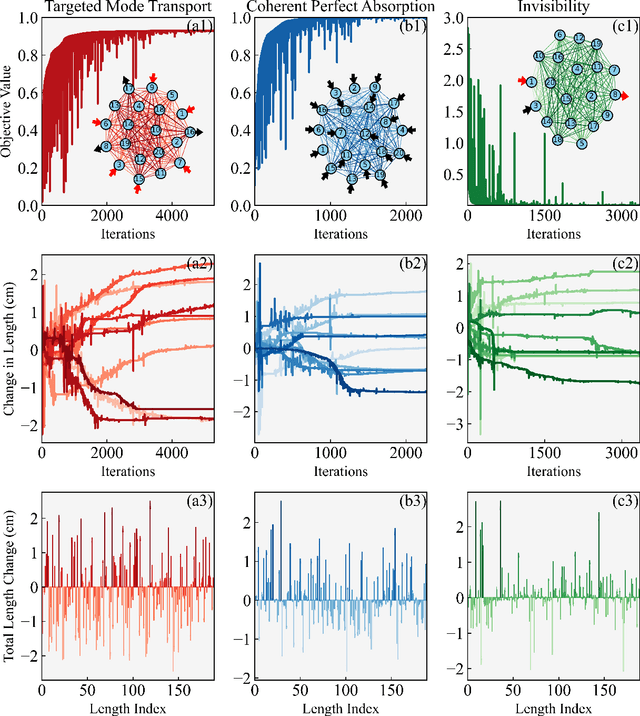
Abstract:Controlling electromagnetic wave propagation in multiple scattering systems is a challenging endeavor due to the extraordinary sensitivity generated by strong multi-path contributions at any given location. Overcoming such complexity has emerged as a central research theme in recent years, motivated both by a wide range of applications -- from wireless communications and imaging to optical micromanipulations -- and by the fundamental principles underlying these efforts. Here, we show that an {\it in-situ} manipulation of the myriad scattering events, achieved through time- and energy-efficient adjoint optimization (AO) methodologies, enables {\it real time} wave-driven functionalities such as targeted channel emission, coherent perfect absorption, and camouflage. Our paradigm shift exploits the highly multi-path nature of these complex environments, where repeated wave-scattering dramatically amplifies small local AO-informed system variations. Our approach can be immediately applied to in-door wireless technologies and incorporated into diverse wave-based frameworks including imaging, power electronic and optical neural networks.
Computational metaoptics for imaging
Nov 14, 2024



Abstract:Metasurfaces -- ultrathin structures composed of subwavelength optical elements -- have revolutionized light manipulation by enabling precise control over electromagnetic waves' amplitude, phase, polarization, and spectral properties. Concurrently, computational imaging leverages algorithms to reconstruct images from optically processed signals, overcoming limitations of traditional imaging systems. This review explores the synergistic integration of metaoptics and computational imaging, "computational metaoptics," which combines the physical wavefront shaping ability of metasurfaces with advanced computational algorithms to enhance imaging performance beyond conventional limits. We discuss how computational metaoptics addresses the inherent limitations of single-layer metasurfaces in achieving multifunctionality without compromising efficiency. By treating metasurfaces as physical preconditioners and co-designing them with reconstruction algorithms through end-to-end (inverse) design, it is possible to jointly optimize the optical hardware and computational software. This holistic approach allows for the automatic discovery of optimal metasurface designs and reconstruction methods that significantly improve imaging capabilities. Advanced applications enabled by computational metaoptics are highlighted, including phase imaging and quantum state measurement, which benefit from the metasurfaces' ability to manipulate complex light fields and the computational algorithms' capacity to reconstruct high-dimensional information. We also examine performance evaluation challenges, emphasizing the need for new metrics that account for the combined optical and computational nature of these systems. Finally, we identify new frontiers in computational metaoptics which point toward a future where computational metaoptics may play a central role in advancing imaging science and technology.
End-to-end metasurface design for temperature imaging via broadband Planck-radiation regression
Sep 13, 2024Abstract:We present a theoretical framework for temperature imaging from long-wavelength infrared thermal radiation (e.g. 8-12 $\mu$m) through the end-to-end design of a metasurface-optics frontend and a computational-reconstruction backend. We introduce a new nonlinear reconstruction algorithm, ``Planck regression," that reconstructs the temperature map from a grayscale sensor image, even in the presence of severe chromatic aberration, by exploiting blackbody and optical physics particular to thermal imaging. We combine this algorithm with an end-to-end approach that optimizes a manufacturable, single-layer metasurface to yield the most accurate reconstruction. Our designs demonstrate high-quality, noise-robust reconstructions of arbitrary temperature maps (including completely random images) in simulations of an ultra-compact thermal-imaging device. We also show that Planck regression is much more generalizable to arbitrary images than a straightforward neural-network reconstruction, which requires a large training set of domain-specific images.
Transcending shift-invariance in the paraxial regime via end-to-end inverse design of freeform nanophotonics
Feb 03, 2023Abstract:Traditional optical elements and conventional metasurfaces obey shift-invariance in the paraxial regime. For imaging systems obeying paraxial shift-invariance, a small shift in input angle causes a corresponding shift in the sensor image. Shift-invariance has deep implications for the design and functionality of optical devices, such as the necessity of free space between components (as in compound objectives made of several curved surfaces). We present a method for nanophotonic inverse design of compact imaging systems whose resolution is not constrained by paraxial shift-invariance. Our method is end-to-end, in that it integrates density-based full-Maxwell topology optimization with a fully iterative elastic-net reconstruction algorithm. By the design of nanophotonic structures that scatter light in a non-shift-invariant manner, our optimized nanophotonic imaging system overcomes the limitations of paraxial shift-invariance, achieving accurate, noise-robust image reconstruction beyond shift-invariant resolution.
Inverse-Designed Meta-Optics with Spectral-Spatial Engineered Response to Mimic Color Perception
Apr 28, 2022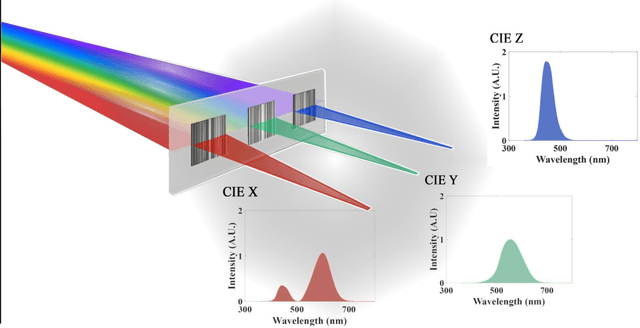

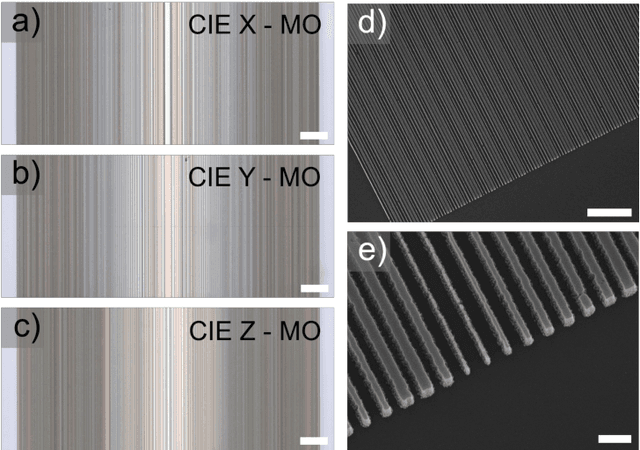
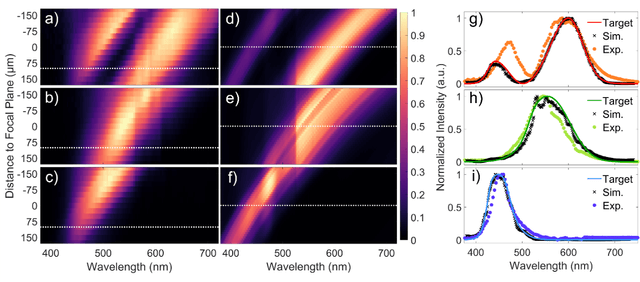
Abstract:Meta-optics have rapidly become a major research field within the optics and photonics community, strongly driven by the seemingly limitless opportunities made possible by controlling optical wavefronts through interaction with arrays of sub-wavelength scatterers. As more and more modalities are explored, the design strategies to achieve desired functionalities become increasingly demanding, necessitating more advanced design techniques. Herein, the inverse-design approach is utilized to create a set of single-layer meta-optics that simultaneously focus light and shape the spectra of focused light without using any filters. Thus, both spatial and spectral properties of the meta-optics are optimized, resulting in spectra that mimic the color matching functions of the CIE 1931 XYZ color space, which links the distributions of wavelengths in light and the color perception of a human eye. Experimental demonstrations of these meta-optics show qualitative agreement with the theoretical predictions and help elucidate the focusing mechanism of these devices.
End-to-End Optimization of Metasurfaces for Imaging with Compressed Sensing
Jan 28, 2022
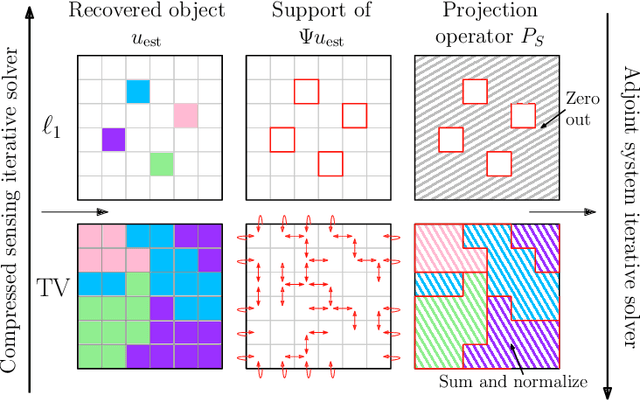
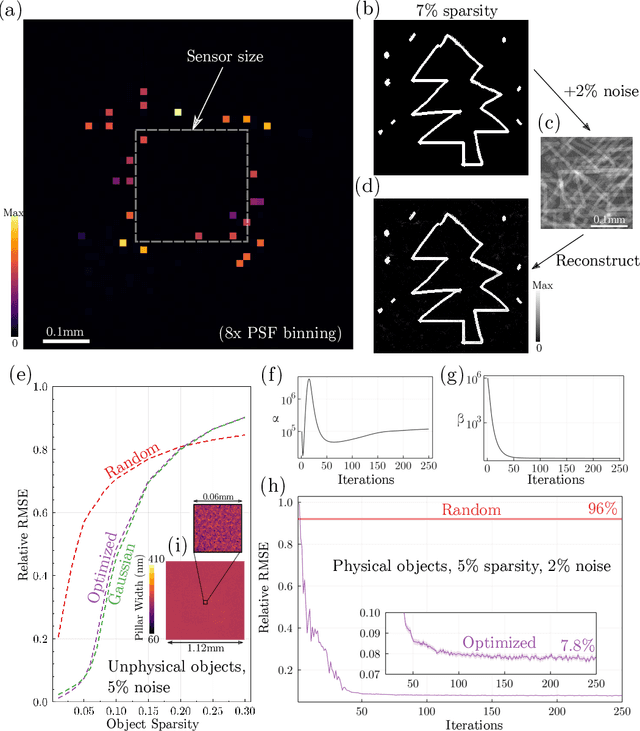
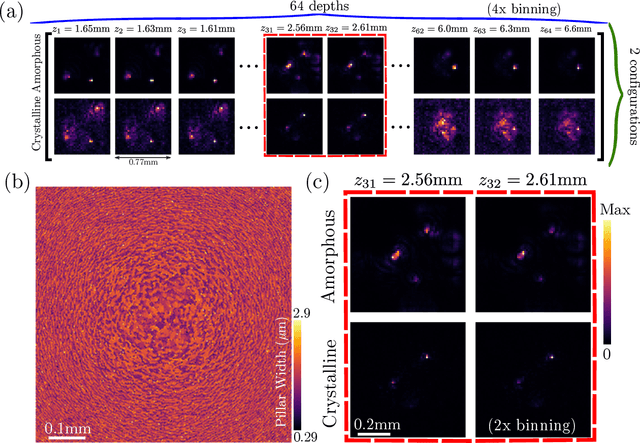
Abstract:We present a method for the end-to-end optimization of computational imaging systems that reconstruct targets using compressed sensing. Using an adjoint analysis of the Karush-Kuhn-Tucker conditions, we incorporate a fully iterative compressed sensing algorithm that solves an $\ell_1$-regularized minimization problem, nested within the end-to-end optimization pipeline. We apply this method to jointly optimize the optical and computational parameters of metasurface-based imaging systems for underdetermined recovery problems. This allows us to investigate the interplay of nanoscale optics with the design goals of compressed sensing imaging systems. Our optimized metasurface imaging systems are robust to noise, significantly improving over random scattering surfaces and approaching the ideal compressed sensing performance of a Gaussian matrix.
 Add to Chrome
Add to Chrome Add to Firefox
Add to Firefox Add to Edge
Add to Edge